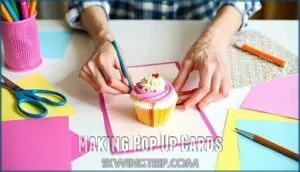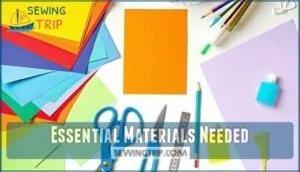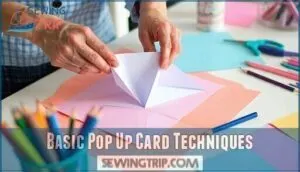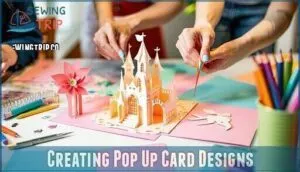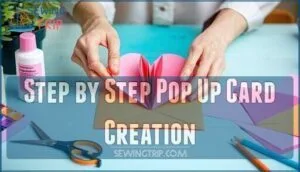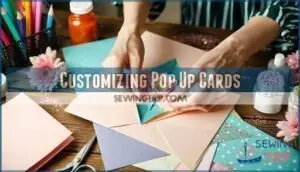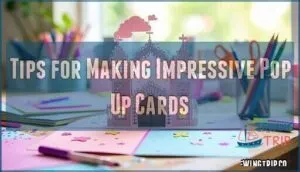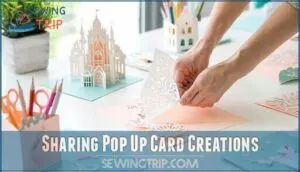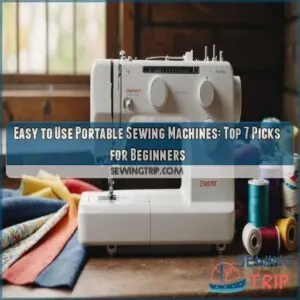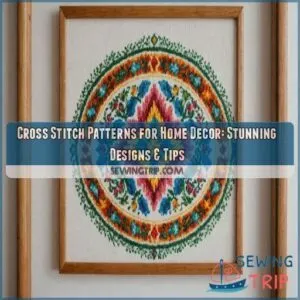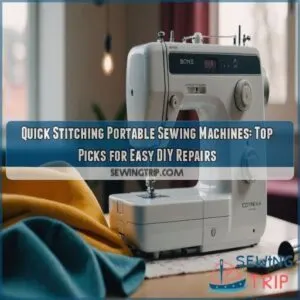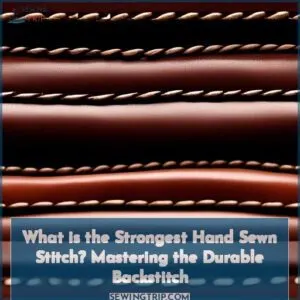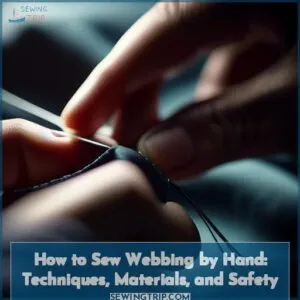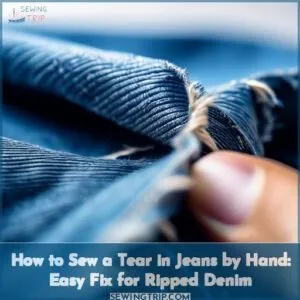This site is supported by our readers. We may earn a commission, at no cost to you, if you purchase through links.
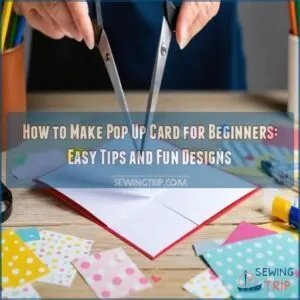 You’ll love making pop up cards—it’s easier than you think!
You’ll love making pop up cards—it’s easier than you think!
Start with a folded piece of cardstock, cut two parallel slits perpendicular to the fold, and push the cut section inward.
Voilà! You’ve got the basic mechanism that’ll spring to life when opened.
Grab scissors, glue stick, and some decorative paper to jazz it up.
Don’t worry about perfection; even wobbly cuts create charm (trust me, my first attempts looked like they survived a paper tornado).
The real magic happens when you see someone’s face light up as your creation unfolds in their hands.
The simple techniques you’ll master open up endless creative possibilities.
Table Of Contents
Key Takeaways
- You’ll need just a few basic supplies to get started – cardstock paper, scissors, and a glue stick are the essentials for creating impressive pop-up cards.
- The "W Method" is the most versatile technique for beginners – simply cut two parallel slits on the folded edge, push the tab forward, and you’ve created the basic pop-up mechanism.
- You can customize your cards with different papers, printable templates, and personal messages to make them unique and meaningful for any occasion.
- Your pop-up cards don’t need to be perfect – even simple designs create a "wow" effect when opened, and the joy comes from both creating and sharing your handmade creations.
Making Pop Up Cards
If you’re new to making pop-up cards, don’t worry—it’s way easier than it looks! Think of it like giving your cards a little “wow” factor by adding movement and surprise.
Here’s a short, engaging blockquote in the same tone as the paragraph:
Pop-up cards bring paper to life with just a few folds—instant "wow" factor without the fancy skills!
Pop-up cards are perfect for any gift occasion, whether it’s birthdays, holidays, or just to say, “Hey, I’m thinking of you.”
It all starts with simple pop-up techniques like folding and creating tabs. You’ll master card mechanisms faster than you’d think.
Plus, it’s a fun skill to share during family crafting time! Theme selection is where things get really creative—pick anything from rainbows to cupcakes.
These beginner card making projects are both simple and exciting, making skill development a breeze. Consider using a die-cutting machine to add precision-cut designs to your pop-up cards.
Ready for a pop-up card tutorial? Let’s do this!
Essential Materials Needed
You don’t need fancy stuff to make awesome pop-up cards—just some basic supplies you probably already have.
Grab some paper, scissors, and glue, and you’re ready to create something amazing!
You can create something amazing with these basic supplies.
Paper Types and Sizes
Picking the right paper is half the fun!
Cardstock works great for sturdiness, while construction paper adds a playful touch.
Printer paper is perfect for first tries—no stress over mistakes!
Think about size: A4 or A5 gives flexibility.
Check GSM (120–160 is ideal) for balance.
Matte finishes reduce glare, so your designs pop beautifully!
Many crafters buy various paper products for their projects.
Adhesives and Glue Sticks
Now that you’ve selected your paper, let’s talk about sticking it all together. A good quality glue stick is your pop-up card’s best friend.
Unlike PVA glue, glue sticks offer faster drying time and less wrinkling when you glue pieces together. Many crafters prefer to use archival quality glue for their projects.
- Kid-friendly adhesives have no strong odors and wash off easily
- Archival quality glues prevent yellowing over time
- Clear-drying options keep your design looking clean
- Precision tip applicators help with detailed elements
Scissors and Cutting Tools
Now that you’ve got your glue ready, let’s talk about what’ll help you shape your pop-up masterpiece. Good scissors are your best friends in card making! You’ll need them for precise cuts that make your pop-ups work properly.
You may need specialized cutting instruments for intricate pop-up designs.
| Cutting Tool | Best For | Beginner Friendly? |
|---|---|---|
| Safety Scissors | Basic cuts | ★★★★★ |
| Precision Scissors | Detail work | ★★★☆☆ |
| Craft Knife | Intricate designs | ★★☆☆☆ |
Remember, blade sharpness matters! Dull scissors can tear your cardstock and ruin your crafting experience.
Basic Pop Up Card Techniques
You’ll transform flat paper into magical 3D creations with these simple pop-up techniques that even craft newbies can master.
Whether you’re using the versatile W method or creating paper chains that spring to life, these beginner-friendly approaches will have you making wow-worthy cards faster than you can say "pop-up surprise!
The W Method
In the context of basic popup techniques, the W Method stands as the most versatile technique in your pop up card arsenal.
This easy popup card method creates a W-shaped fold that springs to life when opened.
Simply cut two parallel slits on the folded edge, push the tab forward, and voilà! It’s perfect for beginners while offering plenty of W-Method variations for advanced creators too.
You can also use die-cutting techniques to reinforce your logo on the card.
Paper Chain Pop Up Cards
While the W method gives you a solid foundation, paper chain pop up cards take your crafting to the next level!
These fun designs feature connected paper elements that create a chain linkage effect when your card opens.
They’re perfect for character themes like butterflies, hearts, and even tigers.
Your paper selection matters here—slightly thicker stock guarantees better joint strength while maintaining flexibility.
Try different pattern variations to make your DIY paper crafts truly unique!
Stand Up Pop Up Cards
While paper chain designs create movement, stand up pop up cards offer a completely different experience.
These DIY paper crafts create an easel mechanism that makes your cards literally stand upright on display.
They’re perfect for adding drawings or photos to your card making projects, and the stability solutions built into these designs guarantee your creation can be proudly displayed on any surface.
You’ll love how these pop up cards showcase your photo integration efforts!
Creating Pop Up Card Designs
You’ll transform simple paper into magical moments when you create your own pop-up card designs using techniques like baubles, concertinas, and 3D elements.
With just a few cuts and folds, you can craft cards that literally jump off the page and make your friends say "wow" every time they open them, creating a lasting wow effect.
Bauble Pop Ups
When you’re ready to take your pop-up cards to the next level, bauble pop-ups offer a fun and versatile option that’ll wow your recipients.
These ornament alternatives create eye-catching dimensional elements that seem to float when the card opens.
- Use different bauble shapes like stars, hearts, or seasonal baubles for holidays
- Add unique embellishments such as glitter, ribbons, or tiny drawings
- Try hanging mechanisms with thin strips of paper for a true ornament effect
Concertina Pop Up Cards
While baubles add holiday cheer, concertina pop-up cards take card making to another level!
These accordion folds create stunning 3D effects when your card opens.
The paper fan technique works beautifully for rainbow designs and Christmas trees.
Fold your accordion paper in equal sections, glue strategically, and watch your popup card spring to life.
It’s like origami meets greeting cards—magical and surprisingly simple!
3D Card Designs
Taking your pop-up cards to the next dimension opens a world of creative possibilities!
3D card designs transform ordinary greetings into memorable keepsakes that jump off the page.
- Layered elements create depth and visual interest
- Shadow boxes frame your central design with dramatic effect
- Kirigami integration combines cutting and folding techniques
- Complex mechanisms add surprising movement
- Unique folds transform flat paper into sculptural elements
You’ll be amazed how simple popup designs can deliver jaw-dropping results!
Step by Step Pop Up Card Creation
You’ll transform plain paper into magical pop-up surprises with just a few simple folds and cuts, no fancy tools required.
Here’s a short, engaging blockquote in the same tone as the paragraph you provided:
Paper, scissors, and a bit of patience transform ordinary sheets into extraordinary pop-up magic that unfolds before your eyes!
Creating your first pop-up card is easier than making toast in the morning, and you’ll feel like a crafting wizard when your creation springs to life every time it’s opened, making you feel like a true magical creator.
Folding and Cutting Paper
Properly folding and cutting paper is often the trickiest part of any popup card tutorial.
Start by folding two pieces of card stock in half widthwise, creating a sharp crease with your fingers or a bone folder.
When making simple popup designs, consider paper grain direction for cleaner fold types.
Make two parallel 1-inch cuts on the folded edge, ensuring precision cutting for your simple paper folding project, which requires attention to detail for a successful popup card tutorial.
Assembling Pop Up Card Components
Now comes the magic moment of bringing your pop-up card to life! Once you’ve cut your papers and folded your tabs, it’s time for card assembly.
Here’s how to guarantee perfect component assembly:
- Position your pop-up mechanism in the center fold
- Apply glue stick to tabs (not the top edges!)
- Check alignment techniques before pressing pieces together
- Allow proper adhesive drying time (about 1-2 minutes)
- Test secure fastening by gently opening and closing
To achieve a polished look, consider how slip stitch edging can add a refined touch.
Attaching Pop Up Images
Now that your card structure is ready, it’s time to bring it to life with pop-up images. This is where the magic happens.
When attaching pop-up images, placement is everything. Your carefully cut shapes need secure attachment to the right spots on your tabs.
| Image Type | Best Adhesive | Attachment Tip |
|---|---|---|
| Paper cutouts | Glue stick | Center on tab |
| Photos | Double-sided tape | Avoid folded edges |
| Cardstock designs | Craft glue | Allow drying time |
| DIY templates | Repositionable glue | Test before final placement |
| 3D elements | Strong adhesive | Reinforce with tabs |
To ensure a professional finish, consider the best adhesive for each image type and follow the provided attachment tips, which include using a glue stick for paper cutouts and double-sided tape for photos.
Customizing Pop Up Cards
You’ll transform your basic pop-up card into a personal masterpiece with simple touches like printed templates, colorful papers, and heartfelt messages that speak louder than store-bought cards ever could.
Now’s your chance to let your creativity run wild – whether you’re adding glitter for a birthday sparkle or pressing in dried flowers for Mom’s special day with a personal touch!
Using Collage and Printable Templates
Why limit yourself to basic pop-up designs when templates and collage techniques can take your cards to the next level?
Printable templates offer endless possibilities for card making beginners while collage techniques add unique texture and personality.
- Print templates on regular paper first, then transfer to cardstock for stability
- Layer different paper cutouts for dimensional image layering effects
- Combine photos with matching template elements for personalized designs
- Use design software to resize templates to fit your specific card dimensions
- Look for free printable sources online with step-by-step instructions for various occasions
Experimenting With Different Papers
Beyond templates, the paper you choose can transform your pop-up cards dramatically.
Try mixing card making supplies of different paper weight – sturdy cardstock for bases and lighter printer paper for delicate elements.
Play with texture effects by combining glossy papers with matte finishes, and use bold color combinations to make designs pop.
Even beginners can experiment with mixed media by incorporating fabric scraps or foil for unexpected paper engineering basics that wow, and create depth using layering techniques.
Adding Personalized Messages
Inside your pop-up card, the message truly makes it shine!
When adding personalized messages, consider Message Placement carefully—whether across from the pop-up or underneath it.
Keep your Message Length brief for maximum impact, and always maintain a Recipient Focus by mentioning their name or inside jokes.
Try different Font Choices or Calligraphy Options to match the occasion.
Remember, in card making for beginners, your heartfelt words transform a handmade card into a cherished keepsake.
Tips for Making Impressive Pop Up Cards
You’ll transform your simple pop-up cards into jaw-dropping masterpieces with just a few clever tricks that won’t break the bank or require an art degree.
From choosing the right thickness of paper to using quick-drying glue sticks (trust me, your fingers will thank you later), these tips will help you create pop-up cards so impressive that your friends might think you secretly moonlight as a paper engineer.
Choosing The Right Paper and Adhesives
The foundation of any eye-catching pop-up card lies in your paper and adhesive choices.
For beginners, medium-weight cardstock offers the perfect balance between flexibility and durability.
When selecting adhesives, consider dry time – glue sticks work great for quick projects, while liquid adhesives provide stronger bonds for complex designs.
Texture effects and color choices dramatically impact your final creation, so don’t be afraid to experiment with different paper weights and archival quality materials.
Using Glue Sticks for Easy Application
Applying adhesive can make or break your pop-up card! A good glue stick is your best friend in card making for beginners.
Unlike liquid glues, they won’t wrinkle your paper as badly. Apply in thin, even strokes from the center outward.
For popup card templates, use quality brands like Elmer’s or UHU that won’t dry out quickly. Store glue sticks cap-down in a cool place to prevent them from drying out.
Adding Decorations and Embellishments
The perfect pop-up card becomes truly magical with the right finishing touches.
Transform your creation from simple to spectacular with these easy embellishments:
- Sprinkle fine glitter on glue-traced outlines for sparkly card edges
- Layer die-cut details over your pop-up elements for added dimension
- Apply stamps with complementary colors to create cohesive backgrounds
Don’t forget about creating matching handmade envelopes – they complete your card making masterpiece with the perfect finishing touches.
Sharing Pop Up Card Creations
You’ll brighten someone’s day when you share your handmade pop-up cards on social media, where fellow crafters can ooh and aah over your paper magic.
Don’t hide your creative talents under a bushel—showing off your 3D masterpieces also spreads joy but spreads joy and connects you with a community that’ll help your cardmaking skills grow even stronger.
Social Media Platforms for Sharing
Several social media platforms offer perfect showcasing opportunities for your pop-up card creations.
Instagram shines brightest for sharing photos and videos of your handmade cards with the crafting community. Pinterest helps organize design ideas, while Facebook groups connect you with fellow enthusiasts.
Remember to use relevant hashtags like #PopUpCards or #PaperCrafting for wider audience engagement. Each platform builds community differently, so choose where your creative style feels most at home with fellow enthusiasts and using relevant hashtags.
Inspiring Others With Pop Up Card Designs
Your creative pop-up card designs can spark joy and imagination in others.
When sharing your creations, think beyond just posting pictures:
- Host mini card-making workshops with friends to teach basic techniques
- Create themed challenges that inspire seasonal or holiday-specific designs
- Share step-by-step tutorials of your favorite pop-up card templates online
Consider incorporating vibrant embroidery floss into your card designs for a unique textural element.
Your unique approach to card making might be exactly what someone else needs to start their own crafting journey and experience the joy of creating something new, which can be a truly imaginative process.
Getting Feedback and Improving Skills
While showing your pop-up cards to friends and family, ask for specific feedback on what catches their eye.
Join online crafting groups where constructive criticism helps with design iteration and skill enhancement.
Don’t take peer reviews personally—they’re stepping stones to improvement, and look for learning resources like YouTube tutorials to master new techniques.
Card making for beginners becomes easier when you’re open to learning from others, and using resources like YouTube tutorials can significantly enhance your skills, making the process more enjoyable and allowing for skill enhancement.
Frequently Asked Questions (FAQs)
How to make a very easy pop-up card?
The paper springs to life as you fold a card in half, cut two parallel slits on the fold, push the tab inward, and glue your design onto it.
You’ve just created magic!
What paper is best for pop-up cards?
For pop-up cards, you’ll want to use cardstock (80-110 lb) for durability and structure.
Construction paper works for simple designs, while thinner printer paper is better for complex folds.
Mix materials for creative effects!
How do I store pop-up cards?
Imagine your precious 3D creations nestled safely away.
Store your pop-up cards flat in acid-free boxes or large envelopes.
You’ll prevent crushing while keeping them dust-free until they’re ready to surprise someone special, and this will help keep them in good condition to be a wonderful surprise.
Can pop-up cards be mailed safely?
Yes, you can mail pop-up cards safely.
Add cardboard inserts, mark as "Do Not Bend," and consider a padded envelope.
They’ll survive the journey if you’ve created sturdy tabs and secured all elements well.
How do I fix broken pop-up elements?
When my nephew’s dragon card flopped sideways, we fixed it with reinforcement tape.
For broken pop-up elements, reinforce with cardstock backing, reglue tabs with strong adhesive, and let dry completely before testing.
Whats the ideal card size for beginners?
For beginners, an A5 card (8" x 3") folded in half works perfectly. It’s large enough to create impressive pop-ups but small enough that you won’t feel overwhelmed by the blank space.
How long does a pop-up card take?
In a blink of an eye, you’ll create magic.
A simple pop-up card takes 15-30 minutes, while more complex designs might need 1-2 hours.
Your time investment depends on design complexity and your experience level.
Conclusion
Remember Sarah’s birthday card that made her gasp with delight? You can create that same magic now that you know how to make pop up cards for beginners!
With some practice, your creations will become more intricate and impressive.
Don’t forget—the joy of pop up cards comes from both making and giving them.
So grab your supplies, let your creativity flow, and watch faces light up when your handmade treasures spring to life!

